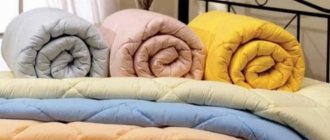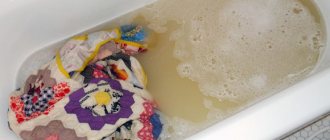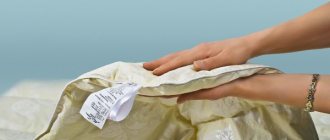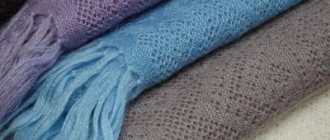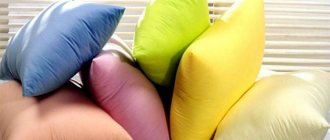Features of padding polyester
The material for sewing a blanket is wear-resistant and weightless. Synthetic winterizer is often used in the textile industry because it has high heat retention properties, is easy to care for, is hypoallergenic and environmentally friendly.
You can wash the material in an automatic washing machine or in the bathroom by hand. If the temperature and drying conditions are observed, the synthetic winterizer does not lose its qualities.
Preparing a blanket for washing
Washing a blanket should begin with preparatory work so that the product does not lose its properties and impeccable appearance.
If it has a protective cover, it is better to remove it and wash the filling separately. It is recommended to baste a non-quilted item around the perimeter. This is necessary to ensure that the padding polyester does not become felted or clumped during washing.
Attention! The blanket must be placed in the washing machine rolled into a tube. This will make it easier to fit into the drum.
Superficial inspection and repair
Before washing, it is necessary to inspect the padding polyester blanket for torn areas, seam separation and abrasions. If such places are found, it is necessary to repair the product - sew it up, put patches on it. Otherwise, the blanket may deteriorate during washing - the torn areas will spread out, the padding polyester will clump into a ball.
Removing dust
Before placing the product in the drum of the washing machine, the product must be vacuumed or knocked out. This is necessary so that during the washing process dust does not clog into the pores of the padding polyester.
Weight check
Each washing machine has a maximum permissible drum loading weight. This condition must be taken into account. If the padding polyester blanket weighs more than normal, you should refuse to wash it in the machine.
What to choose: machine wash or hand wash
Both methods have their pros and cons. The machine method is less labor-intensive, it is easier to control the water temperature, the intensity of exposure, and the amount of detergents.
When wet, the padding polyester becomes too heavy to lift, so you won’t be able to properly wash the blanket by hand. It is easier to rinse a heavy item 2 or more times in a machine; it is almost impossible to do this by hand.
The only advantage of hand washing is its delicate effect. The machine procedure is easier and more correct: you can wash the item without any extra effort.
If the capacity of the washing machine drum does not allow you to load a blanket with padding polyester, it is better to take it to the dry cleaner.
Wash
The synthetic blanket is placed in the drum separately from other things. To ensure that it is evenly distributed in the washing machine during washing, it is recommended to put special balls with the item, which experienced housewives replace with tennis balls. This will prevent the product from crumpling.
Water mode and temperature
The blanket must be washed in the “Delicate wash” or “Synthetic” mode, at a temperature from +30 to +40 ᵒС. Higher rates will harm the product and the filler; the padding polyester will be deformed.
Rinse and spin
Synthetic fiber absorbs detergents well. Therefore, it is necessary to rinse the padding polyester item several times.
It is recommended to spin the blanket at low speeds - about 500. If the washing machine has a drying function, it is better to discard it.
Recommendations for washing synthetic padding pillows
Textiles with padding polyester filling can be washed both in a machine and by hand. The main thing you need to know is that this material cannot withstand prolonged exposure to hot water and automatic spinning at high speeds; it deteriorates from the use of bleach and other aggressive detergents.
Preparing for washing
Before washing, the pillow is placed in a special bag or a regular pillowcase, the dimensions of which are much larger than the dimensions of the product. In addition, you can tighten the pad with ribbons in three places. Additional fastening will not allow the synthetic layers to move and warp; the washed product will better retain its shape.
The volumetric pillow will hardly fit into the drum of the machine. To slightly reduce the size of the product and speed up the process of moistening the internal contents, the bedding should be watered generously before washing. In no case should you soak a pillow for a long time, as you can do with bed linen. Simply pour water on it and put it in the washing machine.
Together with the pillow, a pair of special rubber balls are placed in the drum, the purpose of which is to prevent the padding polyester from falling into clumps.
Detergents
The padding polyester filler has a porous fibrous structure. If you use regular washing powder for cleaning, the detergent particles will get stuck between the polyester fibers and the product will be difficult to rinse. Remaining microparticles of the chemical in contact with the body can cause allergies. In addition, the napkin of a product washed with powder is usually covered with white streaks, the appearance of which is caused by powder settled between the fibers.
To wash pillows and other bedding with synthetic filling, it is advisable to use gels or capsules. Liquid detergents are easily washed out and do not leave stains or unpleasant odors.
Washing mode
Now that the product is prepared for washing, the detergent has been selected, you can proceed directly to work.
- Check to see if there is any bleach or other chemicals left in the powder compartment from the last wash.
- Pour liquid detergent or place a capsule into the machine drum.
- Set the “delicate” mode for synthetics. The water temperature should not exceed +40°C. The drum of a working machine should rotate at a speed of no more than 500 rpm. If it is possible to manually set this parameter, then it is better to use it.
- Turn off automatic spin.
- Upon completion of work, an additional rinse is necessary.
The washed pillow is removed from the machine and laid out on a wire rack over a bathtub or basin to drain off most of the water.
Then the product is carefully kneaded with your hands, trying to remove the remaining moisture without deforming the filler, and wrapped in a terry towel
How to dry pillows correctly?
When the pillow has been washed according to all the rules, it is important to properly dry this voluminous product and try to maintain its fluffiness and softness. Here are some tips on how to dry textiles with padding polyester filling:
- After the bulk of the water has been removed by hand pressing, the pillow is laid out on a horizontal surface.
- The place for drying textiles must be ventilated. This could be a loggia or balcony, a room with an open window or other ventilation.
- Do not dry textiles filled with padding polyester near heating or heating appliances. In this case, the pillow may become deformed and acquire an unpleasant chemical odor.
- You should not choose a drying place in the sun. When exposed to direct sunlight, the product will lose its original appearance.
Drying textiles with synthetic filler must be approached with all responsibility. Every two hours you should turn the product over to the other side and beat it with your hands, trying to break up any lumps that appear.
It happens that even if you scrupulously follow all the recommendations for washing and drying, clots and lumps can be felt inside the filler. Don’t waste time rubbing them with your hands until the pillow is completely dry. It will be much easier to cope with this problem when the padding polyester is completely dry.
Pillows made with synthetic padding should be washed at least once every three months. If you follow the rules for washing and drying products with synthetic filling, it will not be difficult, and your bedding will always remain clean and fresh.
Selection of detergent
It is recommended to wash synthetic winterizer with liquid detergents that do not contain chlorine. Dry powder gets clogged into the pores of the filler, so it can cause allergies and skin irritation.
Top 5 washing gels
For synthetic winterizer blankets, it is better to use gels that do not contain phosphates.
Top 5 gels:
- Biomio bio-sensitive. The gel is suitable for washing all types of fabrics (down jackets, cotton fillers, wool, bamboo), has a softening effect, and prevents the formation of coils. Contains cotton extract, glycerin. Suitable for allergy sufferers and children.
- Frosch (Apple) - a gel has been developed for colored laundry, suitable for hand and machine washing, easy to rinse.
- Weasel with color restoration effect. The gel prevents the blanket from “shedding” and is suitable for washing synthetics and cotton.
- Ariel with Shea butter. The product is suitable for colored fabrics, removes stains, gives things a pleasant aroma and softness.
- Bimax BiMax Color. Contains a stain remover. Suitable for hand washing or machine washing.
When choosing a gel for washing a padding polyester blanket, you need to look at the composition. It is preferable to use a detergent with softeners and natural ingredients.
Distinctive qualities
In the frantic pace of life, simplicity and ergonomics in everything are especially valued. Housewives choose types of home textiles that do not require special care and long fuss with them.
And the least demanding to care for are synthetic fillers. Synthetic blankets have proven themselves well. These things are popular.
There are several types of materials that are combined under the general name “sintepon”. But still they have independent names: wool, synthetic fluff and holofiber.
Distinctive qualities of padding polyester from holofiber, down and wadded blankets:
- The bedspread is light in weight. It is convenient to take it with you on trips, hospitals and fishing in the cold season.
- Does not deform when washed.
- Has good thermal insulation qualities. Perfectly retains heat and volume.
- Low production costs.
- Sintepon is not as hygroscopic as cotton wool. It is safe for health.
Synthetic winterizers have won the attention of consumers. Blankets and jackets made on its basis are very warm and light. And most importantly, they are easy to care for and not expensive, which is what buyers actually like.
This material tolerates water well, so the answer to the question - is it possible to wash a padding polyester blanket in a machine or by hand, is positive.
However, despite its unpretentiousness, you should still follow some recommendations when washing such a product so that it lasts longer. Blankets made from synthetic padding have their own characteristics in care, which are important to consider and follow.
Despite so many positive qualities, this material also has negative sides.
During the washing process, the fibers clump into clumps and are very difficult to straighten out, so you should only wash them at the cycle indicated on the label. In addition, over time, the synthetic winterizer seeps through the outer material and the blanket looks ugly.
When buying such a blanket, pay attention to the raw materials. Ask the seller. Often, to manufacture a product, manufacturers save money and use second-class raw materials, and this reduces the quality and service life of the item.
Handwash
It is difficult to wash a synthetic blanket by hand. When wet, the filler becomes quite heavy. If the product does not fit in the washing machine, then there are no other options for cleaning.
Water temperature for hand washing
A bathtub or large basin must be filled with water at a temperature of no more than 40 degrees. The blanket will not tolerate a hotter wash.
The nuances of hand washing
It is recommended to wash synthetic winterizer products using liquid detergents that can be easily rinsed.
Rinse must be repeated several times. After each procedure, you need to let the blanket drain a little.
It is not recommended to squeeze the product by hand. It is better to fold the blanket in several layers and, using light pressure from the palm of your hand, squeeze the water out of the filler and then let it drain.
How to wash a padding polyester blanket by hand
Not every machine has a spacious drum, so the housewife will have to wash a large item with synthetic padding by hand.
A good result is strict adherence to the instructions.
How to wash a synthetic blanket by hand:
- Fill the bath with water and monitor its temperature using a thermometer.
- Dissolve detergent.
- Place the padding polyester blanket in a container.
- Soak for 1 hour. This is required so that later you can immediately remove the stains with laundry soap and a brush with soft bristles, which wipe the entire surface of the padding polyester product.
- After washing, drain the water, add new water, and wash the product out of the stuffing.
- The water is changed 3 to 4 times until it becomes clear.
- One person will not be able to manually squeeze out excess moisture from the padding polyester material; at least two people will need to do this.
Washed padding polyester accessories are dried outdoors or indoors.
Removing stains
It is easiest to remove any stains immediately after they appear on the surface. If the dirt is small, then you should not completely wash the blanket. You can try to clean only the problem areas of the item.
Fat
Grease stains are the most common type of contamination. You can neutralize them with dishwashing detergent.
Cleaning process:
- Pour water into a container and add dish soap to it. The solution should be concentrated.
- Foam the liquid.
- Apply the product to the stain with a sponge.
- Wait about 10 minutes.
- Wipe with a clean sponge and then with a dry cloth.
If the stained area is large and difficult to wash after using detergent, then the blanket must be washed completely.
Urine
Urine is difficult to remove. A fresh stain can be removed with a vinegar solution:
- Dry the surface of the blanket with paper towels. The remaining urine should be quickly absorbed into them.
- Dilute the vinegar solution in a spray bottle (1 part vinegar to 3 parts water).
- Spray the mixture onto the stain.
- Dry with napkins.
- Sprinkle a thick layer of baking soda onto the problem area and leave for 20-30 minutes. This will allow moisture to be absorbed into the dry soda powder, which will eliminate odor and disinfect the product.
- Remove the stain or wash the item completely.
A stubborn stain is difficult to remove. To do this, you need to follow all the previous steps, but do not remove the soda from the surface, but fill it with hydrogen peroxide. As a result of the chemical reaction, foam is formed, which is recommended to be left on the surface for at least 1.5 hours. After this, the product must be fully or partially washed.
Blood
You can remove blood with hydrogen peroxide. To do this, you need to wash the stain with cold water, blot it with a rag, and then pour it with peroxide. As a result, the contamination should foam. When the reaction is over, you need to wash the stain.
Yellowed areas
Yellow spots on things appear often. To remove them, you need to use a vinegar solution:
- Dilute vinegar or lemon juice with water in a 1 to 1 ratio.
- Apply liquid to the stain.
- Leave for 20-30 minutes.
- Rinse with clean water.
- If necessary, repeat the procedure.
Yellow spots are most often caused by moisture. Therefore, the item must be thoroughly dried and ventilated.
Alcoholic drinks
Any alcoholic drink, traces of it, can be removed with an alcohol solution. To do this you need:
- Dilute alcohol with water in a ratio of 1 to 1.
- Dampen the sponge and wash the stain.
- Wash the product or a separate area.
Alcohol can be replaced with vodka. In this case, there is no need to dilute it with water.
Drying
Drying a large synthetic blanket is difficult. It should drain after washing. If cleaning was done manually, then the blanket must be placed in the bathroom and left for a couple of hours. If the wash was carried out in a machine, then the item can be left in the drum, but the machine door must be slightly open.
After this you need:
- Shake the blanket.
- Place on a flat surface.
- Lightly stretch the item in different directions.
It is best to dry the blanket on a flat surface, turning it over periodically. Optimal conditions are drying in the fresh air. In winter, you can place the blanket in the cold.
Is it possible and how to wash a padding polyester blanket: in a washing machine or by hand?
Warm, soft and airy, and at the same time inexpensive, blankets with padding polyester filling are very popular. Having purchased such bedding, every owner wants it to last as long as possible. In this article we will tell you in detail about all the secrets of caring for a padding polyester blanket. You will learn how often to clean the product, how to wash it correctly in a machine and by hand, how to dry it, and in what cases dry cleaning is needed.
Sintepon has gone astray: problem solving and prevention
Sintepon, with proper care, does not get lost. It can clump for a number of reasons:
- Incorrect tailoring of the item.
- Violation of the washing and drying regime.
- Product wear.
If there is slight deformation, you can straighten the padding polyester through the top cover. Large lumps cannot be eliminated this way. In this case, stripping of the coating will be required.
Preventive measures will help prevent damage to the product:
- The blanket must be quilted with large stitches before washing.
- Along with the product, you should put several washing balls in the drum of the washing machine.
- Strictly observe the washing temperature, choosing the appropriate mode.
If the padding polyester is matted in most of the blanket, then it will be difficult to save the product.
How to dry
After finishing the machine wash, the blanket is left in the machine drum for 1-2 hours to allow the liquid to drain. At the end of manual cleaning, the item is left in a dry bath for the same time.
They dry padding polyester blankets on special horizontal dryers; you can use a simple wide table: terry towels are spread on its surface. As soon as the blanket dries a little, shake it and turn it over to the other side .
This manipulation is repeated several times during the drying process. This prevents the padding polyester from caking, reducing its volume and thickness.
Useful tips
In order for the item to retain its appearance and still retain heat, it is necessary to follow the washing rules. It is recommended to listen to a number of useful tips:
- Blankets should be washed separately from other items.
- You should place laundry balls or tennis balls in the drum.
- It is better to choose gels as a detergent.
- The use of stain removers is not recommended.
If you wash a thing 3-4 times a year, it will not lose its qualities and will retain its appearance for many years.
Is it washable?
The synthetic padding filler is durable, wear-resistant, and warm. It is easy to use, after washing it looks the same as before.
Blankets made from padding polyester can and should be washed at home. This item will survive more than one wash, maintaining its quality and appearance.
Hygiene rules provide for 1 procedure every 3-4 months. You can find out what type of cleansing to choose from the label on the product. The manufacturer must indicate this data.
If the product is not intended for home cleaning, then probably not synthetic padding polyester was used for its production, but a cheaper analogue.
